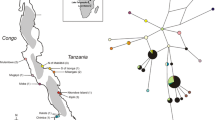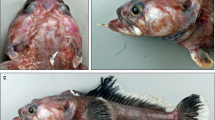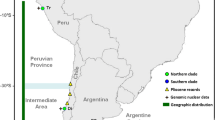Abstract
Panulirus argus (Latreille in Ann Mus Hist Nat Paris 3:388–395, 1804) is the lobster of greatest economic importance throughout its distribution. In this study, mitochondrial (Cytochrome Oxidase I and 16S ribosomal genes) and nuclear (Adenine Nucleotide Transporter gene) sequences were used to evaluate the taxonomic status of P. argus sampled from five sites in the Caribbean Sea and nine sites in the Southwest Atlantic. Phylogenetic analyses indicate that lobsters from the two regions form two monophyletic groups with a molecular divergence similar to that observed between distinct congeneric lobster species and much larger than that found between conspecific lobster populations. Therefore, the Caribbean and the Southwest Atlantic lobster populations originally attributed to P. argus belong to different species, with an estimated time of isolation of around 16 Million years. An important consequence of these findings is that the fisheries of spiny lobsters from the Caribbean and the Southwest Atlantic species must be managed separately.




Similar content being viewed by others
References
Berger WH (2011) Geologist at sea: aspects of ocean history. Ann Rev Mar Sci 3:1–34
Berry PF (1974) A revision of the Panulirus homarus-group of spiny lobsters (Decapoda, Palinuridae). Crustaceana 27:31–42
Boisselier-Dubayle MC, Bonillo C, Cruaud C, Couloux A, Richer de Forges B, Vidal N (2010) The phylogenetic position of the “living fossils” Neoglyphea and Laurentaeglyphea (Decapoda: Glypheidea). C R Biol 333:755–759
Bruce AJ (1975) Coral reef shrimps and their color patterns. Endeavour 34:23–27
Campbell KE Jr, Frailey CD, Romero-Pittman L (2006) The Pan-Amazonian Ucayali Peneplain, late Neogene sedimentation in Amazonia, and the birth of the modern Amazon River system. Palaeogeogr Palaeoclimatol Palaeoecol 239:166–219
Cannas R, Cau A, Deiana AM, Salvadori S, Tagliavini J (2006) Discrimination between the Mediterranean spiny lobsters Palinurus elephas and P. mauritanicus (Crustacea: Decapoda) by mitochondrial sequence analysis. In: Thessalou-Legaki M (ed) Issues of Decapod Crustacean Biology. Hydrobiologia 557:1–4
Chan TY (2010) Annotated checklist of the world’s marine lobsters (Crustacea: Decapoda: Astacidea, Glypheidea, Achelata, Polychelida). Raffles Bull Zool 23:153–181
Curtin TB (1986a) Physical observations in the plume region of the Amazon River during peak discharge. 2. Water masses. Cont Shelf Res 6:53–71
Curtin TB (1986b) Physical observations in the plume region of the Amazon River during peak discharge. 3. Currents. Cont Shelf Res 6:73–86
Diniz FM, Maclean N, Ogawa M, Cintra IHA, Bentzen P (2005) The hypervariable domain of the mitochondrial control region in Atlantic spiny lobsters and its potential as a marker for investigating phylogeographic structuring. Mar Biotechnol 7:462–473
Drummond AJ, Rambaut A (2007) BEAST: Bayesian evolutionary analysis by sampling trees. BMC Evol Biol 7:214–221
FAO (2008) Fisheries Country Profile. The Republic of Suriname, FAO, Rome
FAO (2011) FISHSTAT plus Version 2.3: Universal software for fishery statistical time series. Capture Production 1950–2009. FAO, Rome
Felsenstein J (1981) Evolutionary trees from DNA sequences: a maximum likelihood approach. J Mol Evol 17:368–373
Folmer O, Black M, Hoeh W, Lutz R, Vrijenhoek R (1994) DNA primers for amplification of mitochondrial cytochrome c oxidase subunit I from diverse metazoan invertebrates. Mol Mar Biol Biotechnol 3:294–299
Freitas R, Castro M (2005) Occurrence of Panulirus argus (Latreille, 1804) (Decapoda, Palinuridae) in the Northwest islands of the Cape Verde Archipelago (Central-East Atlantic). Crustaceana 78:1191–1201
Garassino A, Breton G (2010) Panulirus destombesi n. sp. (Crustacea, Decapoda, Palinuridae) de l’Albien (Crétacé inférieur) de Wissant (Pas-de-Calais, France). Geodiversitas 32:391–397
George RW (2005) Tethys Sea fragmentation and speciation of Panulirus spiny lobsters. Crustaceana 78:1281–1309
Glaholt RD, Seeb J (1992) Preliminary investigation into the origin of the spiny lobster, Panulirus argus (Latreille, 1804), population of Belize, Central America (Decapoda, Palinuridea). Crustac Int J Crustac Res 62:159–165
Groeneveld JC, Gopal K, George RW, Matthee CA (2007) Molecular phylogeny of the spiny lobster genus Palinurus (Decapoda: Palinuridae) with hypotheses on the speciation in the NE Atlantic/Mediterranean and SW Indian Ocean. Mol Phylogenet Evol 45:102–110
Guéguen F (2000) Distribution et abondance des poissons démersaux et de quelques autres organismes benthiques marins du plateau continental (0–60 m) de Guyane Française. Comptes Rendus de la Académie des Sciences—Series III—Sciences de la Vie 323:775–791
Guindon S, Gascuel O (2003) A simple, fast, and accurate algorithm to estimate large phylogenies by maximum likelihood. Syst Biol 52:696–704
Hasegawa M, Kishino H, Yano TA (1985) Dating of the human-ape splitting by a molecular clock of mitochondrial DNA. J Mol Evol 22:160–174
Hateley JG, Sleeter TD (1993) A biochemical genetic investigation of spiny lobster (Panulirus argus) stock replenishment in Bermuda. Bull Mar Sci 52:993–1006
Holthuis LB (1959) The Crustacea Decapoda of Suriname (Dutch Guiana). Zool Verh 43:1–296
Holthuis LB (1991) FAO species catalogue. Vol. 13. Marine lobsters of the world. An annotated and illustrated catalogue of species of interest to fisheries known to date. FAO Fisheries Synopsis 125. FAO, Rome
Hoorn C (1993) Marine incursions and the influence of Andean tectonics on the depositional history of Northwestern Amazonia—results of a palynostratigraphic study. Palaeogeogr Palaeoclimatol Palaeoecol 105:267–309
Hoorn C (1996) Miocene deposits in the Amazonian foreland basin. Science 273:122–123
Hoorn C, Guerrero J, Sarmiento GA, Lorente MA (1995) Andean tectonics as a cause for changing drainage patterns in Miocene Northern South-America. Geology 23:237–240
Huelsenbeck JP, Ronquist F (2001) MRBAYES: Bayesian inference of phylogenetic trees. Bioinformatics 17:754–755
ICZN (1999) International Code of Zoological Nomenclature, 4th edn. International Trust for Zoological Nomenclature, London
Kimura M (1980) A simple method for estimating evolutionary rates of base substitutions through comparative studies of nucleotide sequences. J Mol Evol 16:111–120
Knowlton N (1986) Cryptic and sibling species among the decapod Crustacea. J Crustac Biol 6:356–363
Lamarck JBPA (1818) Histoire naturelle des animaux sans vertèbres. Vol. 5:1–612. Imprimerie d’Abel Lanoe, Paris
Latreille PA (1804) Des langoustes du Muséum National d’Histoire Naturelle. Ann Mus Hist nat Paris 3:388–395
Librado P, Rozas J (2009) DnaSP v. 5: A software for comprehensive analysis of DNA polymorphism data. Bioinformatics 25:1451–1452
Maddison WP, Maddison DR (2009) Mesquite: a modular system for evolutionary analysis. Version 2.6. http://mesquiteproject.org
McWilliam PS, Phillips BF (2007) Spiny lobster development: mechanisms inducing metamorphosis to the puerulus: a review. Rev Fish Biol Fish 17:615–632
Naro-Maciel E, Reid B, Holmes KE, Brumbaugh DR, Martin M, DeSalle R (2011) Mitochondrial DNA sequence variation in spiny lobsters: population expansion, panmixia, and divergence. Mar Biol 158:2027–2041
Ovenden JR, Booth J, Smolenski A (1997) Mitochondrial DNA phylogeny of red and green rock lobsters (genus Jasus). Mar Freshw Res 48:1131–1136
Palero F, Crandall KA, Abelló P, Macpherson E, Pascual M (2009) Phylogenetic relationships between spiny, slipper and coral lobsters (Crustacea, Decapoda, Achelata). Mol Phylogenet Evol 50:152–162
Palumbi SR, Martin A, Romano S, Mcmillan WO, Stice L, Grabowski G (1991) The simple fool’s guide to PCR, version 2.0. University of Hawaii, Honolulu
Phillips BF, Melville-Smith R (2006) Panulirus species. In: Phillips BF (ed) Lobsters: biology, management, aquaculture and fisheries. Blackwell Publishing, Singapore
Potter PE (1997) The Mesozoic and Cenozoic paleodrainage of South-America: a natural history. J South Am Earth Sci 10:331–344
Ptacek MB, Sarver SK, Childress MJ, Herrnkind WF (2001) Molecular phylogeny of the spiny lobster genus Panulirus (Decapoda: Palinuridae). Mar Freshw Res 52:1037–1047
Rocha LA (2003) Patterns of distribution and processes of speciation in Brazilian reef fishes. J Biogeogr 30:1161–1171
Sarver SK, Silberman JD, Walsh PJ (1998) Mitochondrial DNA sequence evidence supporting the recognition of two subspecies or species of the Florida spiny lobster Panulirus argus. J Crustac Biol 18:177–186
Sarver SK, Freshwater DW, Walsh PJ (2000) The occurrence of the provisional Brazilian subspecies of spiny lobster (Panulirus argus westonii) in Florida waters. Fish Bull 98:870–873
Silberman JD, Sarver SK, Walsh PJ (1994) Mitochondrial DNA variation and population structure in the spiny lobster Panulirus argus. Mar Biol 120:601–608
Stephens M, Scheet P (2005) Accounting for decay of linkage disequilibrium in haplotype inference and missing data imputation. Am J Hum Genet 76:449–462
Stephens M, Smith NJ, Donnelly P (2001) A new statistical method for haplotype reconstruction from population data. Am J Hum Genet 68:978–989
Tamura K, Peterson D, Peterson N, Stecher G, Nei M, Kumar S (2011) MEGA5: molecular evolutionary genetics analysis using maximum likelihood, evolutionary distance, and maximum parsimony methods. Mol Biol Evol 28:2731–2739
Teske PR, Beheregaray LB (2009) Intron-spanning primers for the amplification of the nuclear ANT gene in decapod crustaceans. Mol Ecol Resour 9:774–776
Thompson JD, Higgins DG, Gibson TJ (1994) CLUSTALW: improving the sensitivity of progressive multiple sequence alignment through sequence weighting, position-specific gap penalties and weight matrix choice. Nucl Acids Res 22:4673–4680
Tsang LM, Chan T-Y, Cheung MK, Chu KH (2009) Molecular evidence for the Southern Hemisphere origin and deep-sea diversification of spiny lobsters (Crustacea: Decapoda: Palinuridae). Mol Phylogenet Evol 51:304–311
Vega FJ, García-Barrera P, Perrilliat MC, Coutiño MA, Mariño-Pérez R (2006) El Espinal, a new plattenkalk facies locality from the Lower Cretaceous Sierra Madre Formation, Chiapas, southeastern Mexico. Rev Mex Cien Geológ 23:323–333
Acknowledgments
We thank D. Almeida, E. Araujo, L. Barbosa, P. Coelho Filho, H. Cunha, M.C.O. Matos, N. Leite Jr., F. Magalhães, R. Monteiro, M.C. Ostrowski, P. Paiva, A. Reis, G. Rey, E. Rios, E. Routledge, and S. Ribeiro for help with sample collections. We also thank S.K. Sarver and J. Gusmão for suggestions on an early version of the manuscript and C. Schrago for helping with the Bayesian divergence time analysis. This paper was made possible by grants from the Brazilian Ministries for Fisheries and Aquaculture (MPA) and Science, Technology and Inovation (MCTI), Conselho Nacional de Desenvolvimento Científico e Tecnológico (CNPq), Coordenação de Aperfeiçoamento de Pessoal de Nível Superior (CAPES), and Fundação Carlos Chagas Filho de Amparo à Pesquisa do Estado do Rio de Janeiro (FAPERJ). This work is part of the MSc thesis of JLT.
Author information
Authors and Affiliations
Corresponding author
Additional information
Communicated by M. I. Taylor.
Rights and permissions
About this article
Cite this article
Tourinho, J.L., Solé-Cava, A.M. & Lazoski, C. Cryptic species within the commercially most important lobster in the tropical Atlantic, the spiny lobster Panulirus argus . Mar Biol 159, 1897–1906 (2012). https://doi.org/10.1007/s00227-012-1977-7
Received:
Accepted:
Published:
Issue Date:
DOI: https://doi.org/10.1007/s00227-012-1977-7




